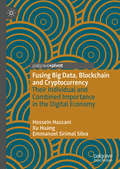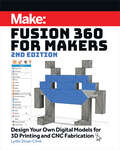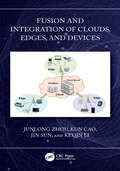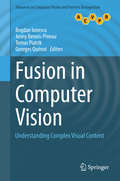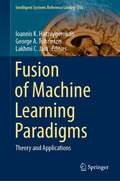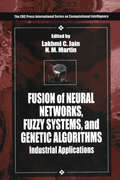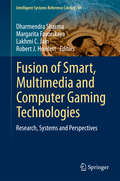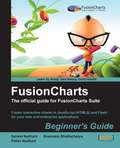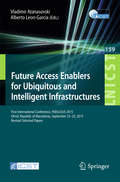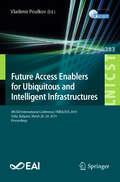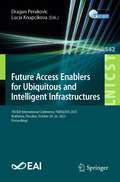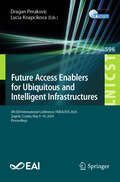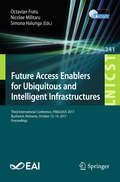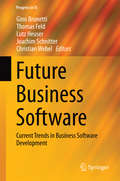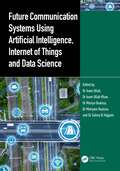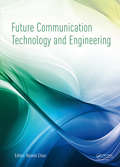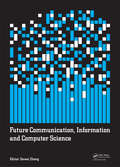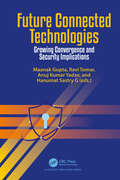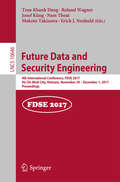- Table View
- List View
Fusing Big Data, Blockchain and Cryptocurrency: Their Individual and Combined Importance in the Digital Economy
by Xu Huang Hossein Hassani Emmanuel Sirimal SilvaAs technology continues to revolutionise today’s economy, Big Data, Blockchain and Cryptocurrency are rapidly transforming themselves into mainstream functions within the financial services industry. This book examines each concept individually, analysing the opportunities and challenges they bring and exploring the potential for future development. The authors further evaluate the fusion of these three important products of the FinTech revolution, illustrating their combined influence on the digital economy. Providing a comprehensive analysis of three innovative technologies, this timely book will appeal to scholars researching innovation in the finance industry and financial services technology more specifically.
Fusion 360 for Makers: Design Your Own Digital Models for 3D Printing and CNC Fabrication
by Lydia Sloan ClineLearn how to use Autodesk Fusion 360 to digitally model your own original projects for a 3D printer or a CNC device. Fusion 360 software lets you design, analyze, and print your ideas. Free to students and small businesses alike, it offers solid, surface, organic, direct, and parametric modeling capabilities.Fusion 360 for Makers is written for beginners to 3D modeling software by an experienced teacher. It will get you up and running quickly with the goal of creating models for 3D printing and CNC fabrication.Inside Fusion 360 for Makers, you'll find:Eight easy-to-understand tutorials that provide a solid foundation in Fusion 360 fundamentalsDIY projects that are explained with step-by-step instructions and color photosProjects that have been real-world tested, covering the most common problems and solutionsStand-alone projects, allowing you to skip to ones of interest without having to work through all the preceding projects firstDesign from scratch or edit downloaded designs. Fusion 360 is an appropriate tool for beginners and experienced makers.
Fusion 360 for Makers: Design Your Own Digital Models for 3D Printing and CNC Fabrication
by Lydia Sloan ClineLearn how to use Autodesk Fusion 360 to digitally model your own original projects for a 3D printer or a CNC device.
Fusion and Integration of Clouds, Edges, and Devices
by Jin Sun Keqin Li Junlong Zhou Kun CaoThis book provides an in-depth examination of recent research advances in cloud-edge-end computing, covering theory, technologies, architectures, methods, applications, and future research directions. It aims to present state-of-the-art models and optimization methods for fusing and integrating clouds, edges, and devices.Cloud-edge-end computing provides users with low-latency, high-reliability, and cost-effective services through the fusion and integration of clouds, edges, and devices. As a result, it is now widely used in various application scenarios. The book introduces the background and fundamental concepts of clouds, edges, and devices, and details the evolution, concepts, enabling technologies, architectures, and implementations of cloud-edge-end computing. It also examines different types of cloud-edge-end orchestrated systems and applications and discusses advanced performance modeling approaches, as well as the latest research on offloading and scheduling policies. It also covers resource management methods for optimizing application performance on cloud-edge-end orchestrated systems.The intended readers of this book are researchers, undergraduate and graduate students, and engineers interested in cloud computing, edge computing, and the Internet of Things. The knowledge of this book will enrich our readers to be at the forefront of cloud-edge-end computing.
Fusion in Computer Vision
by Jenny Benois-Pineau Bogdan Ionescu Tomas Piatrik Georges QuénotThis book presents a thorough overview of fusion in computer vision, from an interdisciplinary and multi-application viewpoint, describing successful approaches, evaluated in the context of international benchmarks that model realistic use cases. Features: examines late fusion approaches for concept recognition in images and videos; describes the interpretation of visual content by incorporating models of the human visual system with content understanding methods; investigates the fusion of multi-modal features of different semantic levels, as well as results of semantic concept detections, for example-based event recognition in video; proposes rotation-based ensemble classifiers for high-dimensional data, which encourage both individual accuracy and diversity within the ensemble; reviews application-focused strategies of fusion in video surveillance, biomedical information retrieval, and content detection in movies; discusses the modeling of mechanisms of human interpretation of complex visual content.
Fusion of Machine Learning Paradigms: Theory and Applications (Intelligent Systems Reference Library #236)
by Lakhmi C. Jain George A. Tsihrintzis Ioannis K. HatzilygeroudisThis book aims at updating the relevant computer science-related research communities, including professors, researchers, scientists, engineers and students, as well as the general reader from other disciplines, on the most recent advances in applications of methods based on Fusing Machine Learning Paradigms. Integrated or Hybrid Machine Learning methodologies combine together two or more Machine Learning approaches achieving higher performance and better efficiency when compared to those of their constituent components and promising major impact in science, technology and the society. The book consists of an editorial note and an additional eight chapters and is organized into two parts, namely: (i) Recent Application Areas of Fusion of Machine Learning Paradigms and (ii) Applications that can clearly benefit from Fusion of Machine Learning Paradigms. This book is directed toward professors, researchers, scientists, engineers and students in Machine Learning-related disciplines, as the hybridism presented, and the case studies described provide researchers with successful approaches and initiatives to efficiently address complex classification or regression problems. It is also directed toward readers who come from other disciplines, including Engineering, Medicine or Education Sciences, and are interested in becoming versed in some of the most recent Machine Learning-based technologies. Extensive lists of bibliographic references at the end of each chapter guide the readers to probe further into the application areas of interest to them.
Fusion of Neural Networks, Fuzzy Systems and Genetic Algorithms: Industrial Applications
by Lakhmi C. Jain N. M. MartinArtificial neural networks can mimic the biological information-processing mechanism in - a very limited sense. Fuzzy logic provides a basis for representing uncertain and imprecise knowledge and forms a basis for human reasoning. Neural networks display genuine promise in solving problems, but a definitive theoretical basis does not yet exist for their design.Fusion of Neural Networks, Fuzzy Systems and Genetic Algorithms integrates neural net, fuzzy system, and evolutionary computing in system design that enables its readers to handle complexity - offsetting the demerits of one paradigm by the merits of another.This book presents specific projects where fusion techniques have been applied. The chapters start with the design of a new fuzzy-neural controller. Remaining chapters discuss the application of expert systems, neural networks, fuzzy control, and evolutionary computing techniques in modern engineering systems. These specific applications include:direct frequency converterselectro-hydraulic systemsmotor controltoaster controlspeech recognitionvehicle routingfault diagnosisAsynchronous Transfer Mode (ATM) communications networkstelephones for hard-of-hearing peoplecontrol of gas turbine aero-enginestelecommunications systems designFusion of Neural Networks, Fuzzy Systems and Genetic Algorithms covers the spectrum of applications - comprehensively demonstrating the advantages of fusion techniques in industrial applications.
Fusion of Smart, Multimedia and Computer Gaming Technologies
by Lakhmi C. Jain Robert J. Howlett Dharmendra Sharma Margarita FavorskayaThis monograph book is focused on the recent advances in smart, multimedia and computer gaming technologies. The Contributions include: ·Smart Gamification and Smart Serious Games. ·Fusion of secure IPsec-based Virtual Private Network, mobile computing and rich multimedia technology. ·Teaching and Promoting Smart Internet of Things Solutions Using the Serious-game Approach. ·Evaluation of Student Knowledge using an e-Learning Framework. ·The iTEC Eduteka. ·3D Virtual Worlds as a Fusion of Immersing, Visualizing, Recording, and Replaying Technologies. ·Fusion of multimedia and mobile technology in audio guides for Museums and Exhibitions: from Bluetooth Push to Web Pull. The book is directed to researchers, students and software developers working in the areas of education and information technologies.
FusionCharts Beginner’s Guide: The Official Guide for FusionCharts Suite
by Sanket Nadhani Pallav NadhaniThe book is written as a practical, step-by-step guide to using FusionCharts Suite. The book not only teaches you the fundamentals and implementation of FusionCharts Suite, but also makes you the data visualization guru among your friends and colleagues by teaching how to select the right chart type and usability tips. Filled with examples, code samples and practical tips in a no-nonsense way, the book is a breeze to read.This book is both for beginners and advanced web developers who need to create interactive charts for their web applications. No previous knowledge of FusionCharts Suite is assumed, and the book takes you right from downloading it to creating complete reports and dashboards.
Future Access Enablers for Ubiquitous and Intelligent Infrastructures
by Vladimir Atanasovski Alberto Leon-GarciaThis bookconstitutes the proceedings of the First International Conference on FutureAccess Enablers for Ubiquitous and Intelligent Infrastructures, FABULOUS 2015,held in Ohrid, Republic of Macedonia, in September 2015. The 39 revised papers cover the broad areas of future wirelessnetworks, ambient and assisted living, smart infrastructures and security andreflect the fast developing and vibrant penetration of IoT technologies in diverseareas of human live.
Future Access Enablers for Ubiquitous and Intelligent Infrastructures: 4th EAI International Conference, FABULOUS 2019, Sofia, Bulgaria, March 28-29, 2019, Proceedings (Lecture Notes of the Institute for Computer Sciences, Social Informatics and Telecommunications Engineering #283)
by Vladimir PoulkovThis book constitutes the refereed post-conference proceedings of the Fourth International Conference on Future Access Enablers for Ubiquitous and Intelligent Infrastructures, FABULOUS 2019, held in Sofia, Bulgaria, in March 2019. This year’s conference topic covers Globalization through Advanced Digital Technologies – as the digitalization in all spheres of life has an impressive influence on communication and daily life in general. The 39 revised full papers were carefully reviewed and selected from 54 submissions. The main topics deal with: healthcare/wellness applications; IoT and sensor networks; IoT security in the digital transformation era; wireless communications and networks; virtual engineering and simulations.
Future Access Enablers for Ubiquitous and Intelligent Infrastructures: 5th EAI International Conference, FABULOUS 2021, Virtual Event, May 6–7, 2021, Proceedings (Lecture Notes of the Institute for Computer Sciences, Social Informatics and Telecommunications Engineering #382)
by Dragan Perakovic Lucia KnapcikovaThis book constitutes the refereed post-conference proceedings of the 5th International Conference on Future Access Enablers for Ubiquitous and Intelligent Infrastructures, FABULOUS 2021, held in May 2021. Due to COVID-19 pandemic the conference was held virtually. This year’s conference topic covers security of innovative services and infrastructure in traffic, transport and logistic ecosystems. The 30 revised full papers were carefully reviewed and selected from 60 submissions. The papers are organized in thematic sessions on: Internet of things and smart city; smart environment applications; information and communications technology; smart health applications; sustainable communications and computing infrastructures.
Future Access Enablers for Ubiquitous and Intelligent Infrastructures: 6th EAI International Conference, FABULOUS 2022, Virtual Event, May 4, 2022, Proceedings (Lecture Notes of the Institute for Computer Sciences, Social Informatics and Telecommunications Engineering #445)
by Dragan Perakovic Lucia KnapcikovaThis book constitutes the refereed post-conference proceedings of the 6th International Conference on Future Access Enablers for Ubiquitous and Intelligent Infrastructures, FABULOUS 2022, held in May 2022. Due to COVID-19 pandemic the conference was held virtually.The 18 revised full papers were carefully reviewed and selected from 70 submissions. The papers are organized in thematic sessions on: Future access networks; Internet of Things and smart city/smart environment applications; Information and communications technology; Sustainable communications and computing infrastructures.
Future Access Enablers for Ubiquitous and Intelligent Infrastructures: 7th EAI International Conference, FABULOUS 2023, Bratislava, Slovakia, October 24–26, 2023, Proceedings (Lecture Notes of the Institute for Computer Sciences, Social Informatics and Telecommunications Engineering #542)
by Dragan Perakovic Lucia KnapcikovaThis book constitutes the refereed post-conference proceedings of the 7th International Conference on Future Access Enablers for Ubiquitous and Intelligent Infrastructures, FABULOUS 2023, held in Bratislava, Slovakia, in October 2023. The 14 revised full papers were carefully reviewed and selected from 35 submissions. The papers are organized in thematic sessions on: future access networks; sustainable communications and computing infrastructures; smart environment applications / scenarios.
Future Access Enablers for Ubiquitous and Intelligent Infrastructures: 8th EAI International Conference, FABULOUS 2024, Zagreb, Croatia, May 9–10, 2024, Proceedings (Lecture Notes of the Institute for Computer Sciences, Social Informatics and Telecommunications Engineering #596)
by Dragan Perakovic Lucia KnapcikovaThis book constitutes the refereed post-conference proceedings of the 8th EAI International Conference on Future Access Enablers for Ubiquitous and Intelligent Infrastructures, FABULOUS 2024, held in Zagreb, Croatia, during May 9–10, 2024. The 14 full papers were carefully reviewed and selected from 35 submissions. The papers are organized in thematic sessions on: Future access networks, Sustainable Communications Computing Infrastructures, Environment Applications Scenarios.
Future Access Enablers for Ubiquitous and Intelligent Infrastructures: Third International Conference, Fabulous 2017, Bucharest, Romania, October 12-14, 2017, Proceedings (Lecture Notes of the Institute for Computer Sciences, Social Informatics and Telecommunications Engineering #241)
by Octavian Fratu Nicolae Militaru Simona HalungaThis book constitutes the refereed post-conference proceedings of the Third International Conference on Future Access Enablers for Ubiquitous and Intelligent Infrastructures, FABULOUS 2017, held in Bucharest, Romania, in October 2017. The 37 revised full papers were carefully reviewed and selected from 61 submissions. The main topics deal with future access networks, Internet of Things and smart city/smart environment applications, communications and computing infrastructures, security aspects in communication and data processing, signal processing and multimedia.
Future Active: Media Activism and the Internet (Media.culture Ser.)
by Graham MeikleFirst Published in 2003. Routledge is an imprint of Taylor & Francis, an informa company.
Future Business Software
by Gino Brunetti Thomas Feld Lutz Heuser Joachim Schnitter Christian WebelWhat will business software look like in the future? And how will it be developed? This book covers the proceedings of the first international conference on Future Business Software - a new think tank discussing the trends in enterprise software with speakers from Europe's most successful software companies and the leading research institutions. The articles focus on two of the most prominent trends in the field: emergent software and agile development processes. "Emergent Software" is a new paradigm of software development that addresses the highly complex requirements of tomorrow's business software and aims at dynamically and flexibly combining a business software solution's different components in order to fulfill customers' needs with a minimum of effort. Agile development processes are the response of software technology to the implementation of diverse and rapidly changing software requirements. A major focus is on the minimization of project risks, e. g. through short, iterative development cycles, test-driven development and an intensive culture of communication.
Future Communication Systems Using Artificial Intelligence, Internet of Things and Data Science
by Dr Inam UllahFuture Communication Systems Using Artificial Intelligence, Internet of Things and Data Science mainly focuses on the techniques of artificial intelligence (AI), Internet of Things (IoT) and data science for future communications systems.The goal of AI, IoT and data science for future communications systems is to create a venue for industry and academics to collaborate on the development of network and system solutions based on data science, AI and IoT. Recent breakthroughs in IoT, mobile and fixed communications and computation have paved the way for a data‑centric society of the future. New applications are increasingly reliant on machine‑to‑machine connections, resulting in unusual workloads and the need for more efficient and dependable infrastructures. Such a wide range of traffic workloads and applications will necessitate dynamic and highly adaptive network environments capable of self‑optimization for the task at hand while ensuring high dependability and ultra‑low latency.Networking devices, sensors, agents, meters and smart vehicles/systems generate massive amounts of data, necessitating new levels of security, performance and dependability. Such complications necessitate the development of new tools and approaches for providing successful services, management and operation. Predictive network analytics will play a critical role in insight generation, process automation required for adapting and scaling to new demands, resolving issues before they impact operational performance (e.g., preventing network failures and anticipating capacity requirements) and overall network decision‑making. To increase user experience and service quality, data mining and analytic techniques for inferring quality of experience (QoE) signals are required.AI, IoT, machine learning, reinforcement learning and network data analytics innovations open new possibilities in areas such as channel modeling and estimation, cognitive communications, interference alignment, mobility management, resource allocation, network control and management, network tomography, multi‑agent systems and network ultra‑broadband deployment prioritization. These new analytic platforms will aid in the transformation of our networks and user experience. Future networks will enable unparalleled automation and optimization by intelligently gathering, analyzing, learning and controlling huge volumes of information.
Future Communication Technology and Engineering: Proceedings of the 2014 International Conference on Future Communication Technology and Engineering (FCTE 2014), Shenzhen, China, 16-17 November 2014
by Kennis ChanThis volume contains the papers presented at the 2014 International Conference on Future Communication Technology and Engineering (FCTE2014), taking place in Shenzhen, China from 16-17 November 2014. Communication technologies are developing quickly and there are more possibilities for future communication technologies provided by the achievements made, rather than limitations. At the convention, innovative and inspiring ideas were presented; certain controversial topics were discussed (e.g. what are the most efficient/convenient methods for information communication) and what is the most probable prospect for future communication technology. It is difficult to make any definite conclusions from these presentations and discussions, but the desire and drive for improvement and development shown by the participants/authors are surely remarkable and respectable. In this book, 70 papers are included, chosen from hundreds of submissions contributed by scientists from various countries and regions, after careful reading and discussing by a team of reviewers. These papers cover almost every possible aspect of communication technology; including communication systems, automation and control engineering, electrical engineering, AI algorithms, signal processing, data mining, and knowledge-based systems.
Future Communication, Information and Computer Science: Proceedings of the 2014 International Conference on Future Communication, Information and Computer Science (FCICS 2014), May 22-23, 2014, Beijing, China.
by Dawei ZhengThe 2014 International Conference on Future Communication, Information and Computer Science (FCICS 2014) was held May 22-23, 2014 in Beijing, China. The objective of FCICS 2014 was to provide a platform for researchers, engineers and academics as well as industrial professionals from all over the world to present their research results and development activities in Computer, Network and Information Technology and Communication Engineering.
Future Connected Technologies: Growing Convergence and Security Implications
by Ravi Tomar Maanak Gupta Anuj Kumar Yadav Sastry G HanumatThe main aim of the book is to familiarize readers with the concepts of convergence of different connected and smart domains that are assisted by Cloud Computing, core technologies behind Cloud Computing, driving factors towards Cloud Computing, and security challenges and proposed solutions in Cloud Computing. The book covers not only the cloud, but also other pertinent topics such as Machine Learning, Deep Learning, IoT and Fog/Edge Computing. The last section of the book mainly focuses on the security aspects of connected technologies. The highpoints of the book is that it reviews the relation and combination of the mentioned topics, which together creates a better understanding about almost every aspect of Cloud Computing & related technologies.
Future Crimes
by Marc GoodmanOne of the world's leading authorities on global security, Marc Goodman takes readers deep into the digital underground to expose the alarming ways criminals, corporations, and even countries are using new and emerging technologies against you--and how this makes everyone more vulnerable than ever imagined. Technological advances have benefited our world in immeasurable ways, but there is an ominous flip side: our technology can be turned against us. Hackers can activate baby monitors to spy on families, thieves are analyzing social media posts to plot home invasions, and stalkers are exploiting the GPS on smart phones to track their victims' every move. We all know today's criminals can steal identities, drain online bank accounts, and wipe out computer servers, but that's just the beginning. To date, no computer has been created that could not be hacked--a sobering fact given our radical dependence on these machines for everything from our nation's power grid to air traffic control to financial services. Yet, as ubiquitous as technology seems today, just over the horizon is a tidal wave of scientific progress that will leave our heads spinning. If today's Internet is the size of a golf ball, tomorrow's will be the size of the sun. Welcome to the Internet of Things, a living, breathing, global information grid where every physical object will be online. But with greater connections come greater risks. Implantable medical devices such as pacemakers can be hacked to deliver a lethal jolt of electricity and a car's brakes can be disabled at high speed from miles away. Meanwhile, 3-D printers can produce AK-47s, bioterrorists can download the recipe for Spanish flu, and cartels are using fleets of drones to ferry drugs across borders. With explosive insights based upon a career in law enforcement and counterterrorism, Marc Goodman takes readers on a vivid journey through the darkest recesses of the Internet. Reading like science fiction, but based in science fact, Future Crimes explores how bad actors are primed to hijack the technologies of tomorrow, including robotics, synthetic biology, nanotechnology, virtual reality, and artificial intelligence. These fields hold the power to create a world of unprecedented abundance and prosperity. But the technological bedrock upon which we are building our common future is deeply unstable and, like a house of cards, can come crashing down at any moment. Future Crimes provides a mind-blowing glimpse into the dark side of technological innovation and the unintended consequences of our connected world. Goodman offers a way out with clear steps we must take to survive the progress unfolding before us. Provocative, thrilling, and ultimately empowering, Future Crimes will serve as an urgent call to action that shows how we can take back control over our own devices and harness technology's tremendous power for the betterment of humanity--before it's too late.From the Hardcover edition.
Future Crimes
by Marc GoodmanNEW YORK TIMES and WALL STREET JOURNAL BESTSELLER ONE OF THE WASHINGTON POST'S 10 BEST BOOKS OF 2015One of the world's leading authorities on global security, Marc Goodman takes readers deep into the digital underground to expose the alarming ways criminals, corporations, and even countries are using new and emerging technologies against you--and how this makes everyone more vulnerable than ever imagined. Technological advances have benefited our world in immeasurable ways, but there is an ominous flip side: our technology can be turned against us. Hackers can activate baby monitors to spy on families, thieves are analyzing social media posts to plot home invasions, and stalkers are exploiting the GPS on smart phones to track their victims' every move. We all know today's criminals can steal identities, drain online bank accounts, and wipe out computer servers, but that's just the beginning. To date, no computer has been created that could not be hacked--a sobering fact given our radical dependence on these machines for everything from our nation's power grid to air traffic control to financial services. Yet, as ubiquitous as technology seems today, just over the horizon is a tidal wave of scientific progress that will leave our heads spinning. If today's Internet is the size of a golf ball, tomorrow's will be the size of the sun. Welcome to the Internet of Things, a living, breathing, global information grid where every physical object will be online. But with greater connections come greater risks. Implantable medical devices such as pacemakers can be hacked to deliver a lethal jolt of electricity and a car's brakes can be disabled at high speed from miles away. Meanwhile, 3-D printers can produce AK-47s, bioterrorists can download the recipe for Spanish flu, and cartels are using fleets of drones to ferry drugs across borders. With explosive insights based upon a career in law enforcement and counterterrorism, Marc Goodman takes readers on a vivid journey through the darkest recesses of the Internet. Reading like science fiction, but based in science fact, Future Crimes explores how bad actors are primed to hijack the technologies of tomorrow, including robotics, synthetic biology, nanotechnology, virtual reality, and artificial intelligence. These fields hold the power to create a world of unprecedented abundance and prosperity. But the technological bedrock upon which we are building our common future is deeply unstable and, like a house of cards, can come crashing down at any moment. Future Crimes provides a mind-blowing glimpse into the dark side of technological innovation and the unintended consequences of our connected world. Goodman offers a way out with clear steps we must take to survive the progress unfolding before us. Provocative, thrilling, and ultimately empowering, Future Crimes will serve as an urgent call to action that shows how we can take back control over our own devices and harness technology's tremendous power for the betterment of humanity--before it's too late.From the Hardcover edition.
Future Data and Security Engineering
by Josef Küng Roland Wagner Tran Khanh Dang Nam Thoai Makoto Takizawa Erich J. NeuholdThis book constitutes the refereed proceedings of the Third International Conference on Future Data and Security Engineering, FDSE 2016, held in Can Tho City, Vietnam, in November 2016. The 27 revised full papers and 2 short papers presented were carefully reviewed and selected from 115 submissions. They have been organized in the following topical sections: Big Data Analytics and Cloud Data Management; Internet of Things and Applications; Security and Privacy Engineering; Data Protection and Data Hiding; Advances in Authentication and Data Access Control; Access Control in NoSQL and Big Data; Context-based Data Analysis and Applications; Emerging Data Management Systems and Applications.
